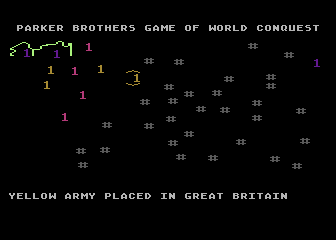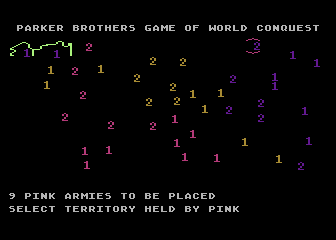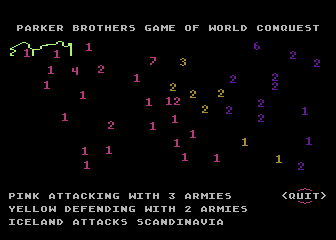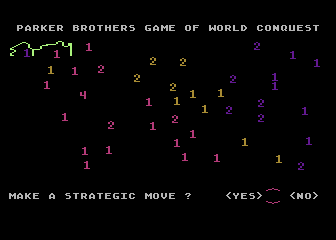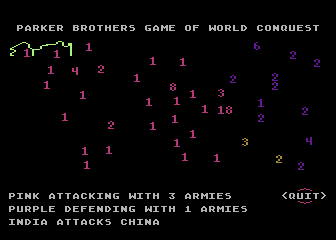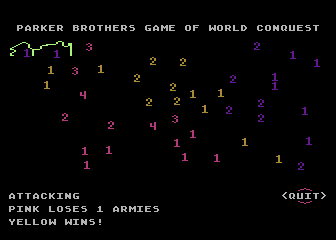|
|
Risk
|
Name:
|
Risk |
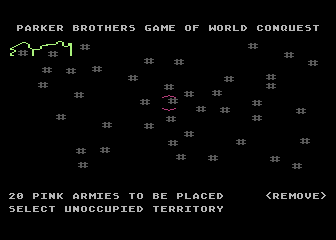 |
| Company: | Parker Brothers | |
|
Model #:
|
N/A | |
|
Programmer:
|
Steve Kranish | |
| Year: | 1983 | |
|
Released?
|
No
|
|
|
Notes:
|
Despite being mentioned in a catalog, the Atari 5200 version was never started. |
Before they decided to try their hand at video games, Parker Brothers (now owned by Hasbro) was originally a board game company. Founded by George S. Parker in 1883, Parker Brothers was responsible for releasing many enduring board games including Monopoly, Clue, Sorry, and Risk. Since Parker Brothers owned the rights to all these famous games, it was only natural that they'd want to make computerized versions. So in 1983 it was decided that Risk would be created for the Atari 8-bit computers and Atari 5200.
As the title screen indicates, Risk is a game of world conquest. The object of the game is to have your armies capture all 42 territories on the world map. While the game can be played with up to six players, the best Risk games are usually played with 3-4 players. At the start of the game, each player places one of their armies in a territory until the entire map is 'claimed'. Once each territory has at least one player in it, players can place additional armies into each territory until all the armies are placed. At the start of each turn, each player receives bonus armies to place. The amount of bonus armies is determined by:
1. The number of territories the player occupies
2. The number of complete continents a player occupies
3. The number of matched Risk card sets he can exchange for armies.
Once all the bonus armies are placed, the player can now enter the attack phase of the game.
In the attack phase a player can mount an assault on a territory owned by another player. The out come of the battle is determined by a series of dice rolls (kind of like D&D). In this version of the game, the computer takes care of all the dice rolling and the player is only shown the result. The number of attack dice rolled (1 to 3) is determined by the size of the attacking army. Therefore a large attacking force would roll three dice, resulting more extreme wins or loses (up to 3 at a time). A player may attack any neighboring territory as long as he has at least two armies in the attacking territory (no suicide 1 army charges).
Once the attack has begun the player may stop at any time, if the attack is not stopped it continues until one army is defeated. Once the defending army is defeated the conquering army moves anywhere from one to three troops (depending on the number of dice rolled) into the conquered territory (this is why you need at least two armies to attack), although more troops can be moved in if the player desires. After the attack phase has ended the player can than make a 'Strategic Move' and move troops from one territory he owns to another.
The game continues in this fashion until one player has completely conquered the world.
Since this prototype was never completed, there are some differences and missing features in the game. This prototype appears to be permanently set to three human players (the minimum required), while the real board game can be played with up to six. This is due to the fact that the computer AI was never implemented. Another change is in the number of armies given to each player. In a normal Risk game set up for three people each player would get 35 armies, however in this version each player only receives 20 armies (perhaps this was done to speed up the game?). Also missing in the prototype is the outline of the world map, which was just starting to be worked on when the game was canceled (notice how Alaska had started to be drawn).
Perhaps the biggest change in this prototype is that the card deck is missing. In the real board game there is a deck of cards which contain pictures of either a horseman, cannon, or solider, along with the name of a territory. These cards are used to gain more armies by matching pictures as follows:
1. Three of the same design (horseman, cannon, soldier)
2. One of each design
3. Any two cards plus a wild card
In addition, if any of the three cards in the match depicts a territory the player occupies, he earns another two armies, which must be placed immediately on that particular territory. Each player draws one card for each new territory he has conquered at the end of a turn.
The card deck was left out for two reasons: One, it was really only used to speed up the game and therefore not was necessary because the computerized version already moved at a fast pace. Two, there was no way to show the cards that each player held without showing them to everyone else. Due to these reasons, it was decided to leave the card deck out of the game.
Although Risk was never completed, it's still a blast to play. Since all the basic gameplay is intact, Risk is one of the few incomplete prototypes that is actually fully playable. The computerized version of Risk automates some of the dull tasks such as calculating the number of armies each player receives, moving tokens, and rolling dice (endless rolls of the die), which ultimately speeds up the game. The automated cursor which automatically moves to the appropriate command or territory is also a nice touch. It's a shame that Risk was never completed, as it would have been a nice addition to the Atari 8-bit library.
| Version | Cart Text | Description |
| ?/??/83 | Risk | 85% Complete |

